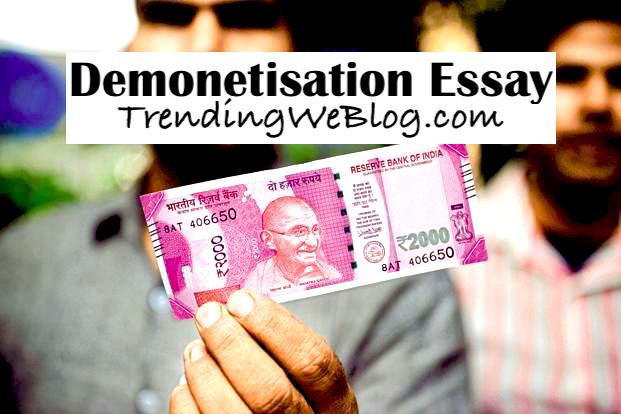Essay on Demonetisation – Demonetisation essay for Class 3, 4, 5, 6, 7, 8, 9, 10, 11, 12, college and SSC students. Find a paragraph, long and short essay on Demonetisation for Students. Learn everything about essay on demonetisation in 350 words, Essay on Demonetisation in 400 words and Essay on Demonetisation in 1000 words.
Demonetisation Meaning and Definition
It is an act of stripping of currency unit of its status as legal tender. An act of stripping a currency unit of its status as legal tender.
Essay on Demonetisation in English

Demonetisation Essay
Essay on Demonetisation 200 Words
On 8th November 2016, the Prime Minister of India, Narendra Modi, in a surprise move, announced the demonetisation of 500 and 1000 currency notes. Rs 15.44 lakh crore worth of notes stopped being legal tender. As a countermeasure to the rampant corruption and penetration of black money into the economy.
The step was taken to curb the rise of tax evasion through black money, land a major hit to forgery operations and would reduce criminal activities like human trafficking, money laundering, terrorist activities etc. It boosts to cashless transactions and transparency in the economy.
It increases the liquidity in banks which result in lower interest rates. Many eminent economists said that it would not be effective in curbing black money and termed it a hollow move. Around 99% of cash returned to the banking system.
This was a sudden announcement without proper planning. Drop in GDP growth, fall in industrial output, loss of job and small businesses. Deaths, cash shortage and forgery by bank employees and other businesses.
Although the objectives of demonetisation were noble; the process of implementation was sadly not efficient. However it gave rise to a Less-Cash economy and resulted in a transparent financial system. This step will transform India from a cash based economy to a less cash economy with more emphasis on the Digital transaction.
Essay on Demonetisation 250 Words
It all started with an announcement by the Prime Minister Narendra Modi on 9th November 2016. His words echoed and the nation was under the sway of an economic reform ‘demonetisation’. It refers to a state when a country stops using currency notes of certain denominations, hence these notes are no longer a legal tender. Demonetisation in India was done with a view to countering the ill-effects of black money.
Black money flows in the veins of nefarious activities like terrorism, illegal racketeering, money laundering and sometimes real estate. Demonetisation is expected to put a check on the circulation of excessive counterfeit currency notes and reverse the edict of the bad money driving out good money. Though a bold step, demonetisation has its own challenges. Lack of proper infrastructures like ATM’s and banks is the foremost of them also inadequate digital platforms for exchange of money Hurt equally. An immediate dearth of money in the hands of people can push the economy towards a downward spiral.
However, these challenges can be dealt with, effectively by supplementing the country with a myriad number of ATM’s keeping the flow of money unhindered. Simultaneously digital payment platforms should be encouraged. Social and print media should be used to promote people for switching from cash transactions to digital transfers. Altogether the scope of digitalization should take urban as well as rural India under its ambit.
With proper planning and strategy, economic reforms like demonetisation can revitalize and rejuvenate the economy of a nation and can help it achieve socio-economic growth and development.
Essay on Demonetisation 350 words
Demonization is the reinterpretation of polytheistic deities as evil, lying demons by other religions, generally monotheistic and henotheistic ones. The term has since been expanded to refer to any characterization of individuals, groups, or political bodies as evil. This action removes the black money in the economy. Black money in the economy increases inflation and due to excessive currency devaluation, the government does the demonetisation.
In 2016, the Indian government decided to demonetise the 500 and 1000 rupee notes, the two biggest denominations in its currency system; these notes accounted by eighty-six percent of the country’s circulation cash. With little warning, India’s Prime Minister Narendra Modi announced to the citizen of India on national televise. After the conference, those notes were worthless and effective immediately – exchange tea for newly introduced 2000 rupee and 500 rupee bill.
The one rupee note was the first banknote printed by independent India. 10,000 rupees is the highest denomination RBI has printed in its history. 1,000 rupees and 10,000 rupees notes were in circulation between 1938 and 1946 but were eventually demonetised. 1,000 rupees, 5,000 rupees, and 10,000 rupees notes were reintroduced in 1954 and demonetised in 1978.
Denominations of 1 paise, 2 paise, 3 paise, 5 paise, 10 paise, 20 paise, and 25 paise were in circulation till June 30, 2011, but were then withdrawn. • Mahatma Gandhi (MG) series notes introduced in 1996 are being replaced by the MG series 2005 notes with some additional security features. Pre-2005 banknotes ink can be exchanged at any bank branch till June 30, 2015
This move will ameliorate amount of tax collection of government. The same can be used for the development of the school, girls education, basic human needs, roads and so on. Cashless transaction ton will be transparency in economy
People of India face many problems, it’s very difficult for more than half the population who are not well versed with the card transaction. Temporary effect on terrorist, transport and other small industries and business.
Many countries have done demonetisation for example Soviet Union, Zimbabwe, and Myanmar, etc but only India has successfully implemented demonetisation on such a large scale. People have faced many problems but this decision of the G government will benefit the economy of India in the long run.
Essay on Demonetisation 400 words
November 8, 2016, will remain a memorable day in the history of Independent India for a long time to come. It was the day when Government made the announcement that higher denomination notes, i.e. Rs 500 & Rs 1000 currency notes, which then constituted 86% of the currency notes under circulation, will stop being legal tender from thence midnight. The government explained that demonetisation step will help in curbing black money hoarded in the form of cash and will check the inflow of fake currency notes from neighbouring countries aimed at disrupting Indian economy.
Black money hoarded in the form of cash is usually in the form of higher denomination notes because of reasons like less storage space requirement & easy high-value transactions. Because of demonetisation step, this form of black money will become worthless as it will be near to impossible to exchange it with existing or newly introduced legal tenders. Demonetisation step will be a setback to the parallel economy which severely affects the growth of our country. Also, it is worth noting that demonetisation step has encouraged online transactions and more people are moving towards an electronic form of cash transactions. This is a positive move as online transactions are easy to carry out on the behalf of citizens and easy to monitor on the behalf of Government.
At the same time, this step gave rise to a cumbersome situation for the citizens of India. Since the higher denomination notes became illegal tender overnight and a time period of 50 days was given for exchange of such notes possessed, if any, it resulted in a state of chaos in the country. There was cash crunch at the banks, ATMs dried out and there appeared long queues outside banks & ATMs all over India. Moreover, the introduction of Rs 2000 currency note at that point of time only aggravated the situation because of lack of existing legal tenders for exchange.
Though this step of government was well-intentioned but a better planning from government’s end could have avoided the state of chaos and unnecessary wastage of time & energy on the account of common people. The government while maintaining the secrecy could have kept enough cash reserve ready to flood the market with the announcement More kiosks should have been set up for easy exchange within the prescribed limit.
Though illegal cash hoarding constitutes only a small fraction of black money as compared to that existing in the form of real estate & gold, such step can be perceived as a positive move from the Government and more such steps are envisaged in the near future with better planning.
Essay on Demonetisation 450 words
On November 8, 2016, the government announced a historic measure, with profound implications for the economy. The two largest denomination notes, Rs 500 and Rs 1000, were “demonetised” with immediate effect, ceasing to be legal tender except for a few specified purposes. At one fell stroke, 86 percent of the cash in circulation was thereby rendered invalid.
The aim of the action was fourfold: to curb corruption; counterfeiting; the use of high denomination notes for terrorist activities; and especially the accumulation of “black money”, generated by income that has not been declared to the tax authorities.
It followed a series of earlier efforts to curb such illicit activities, including the creation of the Special Investigative Team (SIT) in the 2014 budget; the Black Money and Imposition of Tax Act 2015; Benami Transactions Act 2016; the information exchange agreement with Switzerland; changes in the tax treaties with Mauritius, Cyprus and Singapore; and the Income Disclosure Scheme. Demonetisation was aimed at signalling a regime change, emphasizing the government’s determination to penalize illicit activities and the associated wealth.
India’s demonetisation is unprecedented in international economic history, in that it combined secrecy and suddenness amidst normal economic and political conditions. All other sudden demonetisations have occurred in the context of hyperinflation, wars, political upheavals, or other extreme circumstances. But the Indian economy had been growing at the fastest clip in the world on the back of stable macroeconomics and an impressive set of reforms.
India’s action is not unprecedented in its own economic history: there were two previous instances of demonetisation, in 1946 and 1978. The public debate on demonetisation has raised three sets of questions. First, broader aspects of management, as reflected in the design and implementation of the initiative. Second, its economic impact in the short and medium run. And, third, its implications for the broader vision underlying the future conduct of economic policy.
There have been reports of job losses, declines in farm incomes, and social disruption, especially in the informal, cash-intensive parts of the economy. The higher the amount of cash in circulation, the greater the amount of corruption, as measured by Transparency International. In this sense, attempts to reduce the cash in an economy could have important long-term benefits in terms of reducing levels of corruption.
The government has initiated a war against corruption and black money but this must be treated as a beginning and further steps should be taken to stop the generation of black money and the need to do so. Only then will this decision of demonetising high denomination currency hold the significance the government has intended it to.
Essay on Demonetisation 1000 Words
On 8th of November 2016 government announce that rupees 500 and 1000 notes will no longer be legal tender. The major objectives behind this announcement or behind this step was to curb corruption, black money and to filter out the counterfeit notes which existed in the economy. The government also said that it will be a major step towards the cashless society. One year ago a similar step was taken in Zimbabwe. But in Zimbabwe, this step was taken because of hyperinflation. People had to carry a bundle of notes to buy even small things. Let’s suppose even to buy a cup of tea they had to pay in bundles of notes. So Zimbabwe government decide to demonetise the notes. Then they introduced higher denomination notes but in this scenario, it is not because of hyperinflation or because of deflation. The main intention of the government is to curb black money that existed in our country like money laundering drug trafficking and bribing all these scenarios high denomination note is preferred.
Facts
Before 9th of November 2016, rupees 500 and 1000 constituted 86% of ‘value’ of notes which existed in our economy. The total value of notes which existed in our economy till then was rupees sixteen thousand four hundred fifteen billion.
Between 2011 and 2016 the circulation of notes increased by 40% that of rupees 500 notes increase 75% and rupees 1000 notes increased by 109%. But the economy spending by only 30 percent. The value of notes that increase by much higher value than the expansion of the economy. So where did the notes go? They have gone into the parallel or shadow economy, which makes black money. The parallel or shadow economy of our country is 30% of our GDP. Our GPD right now is around 2 trillion US dollars. So the shadow of an economy which is running in our country is of the value of 30% of our GPD. The entire black money of our country only 72% is held in foreign accounts and only 28% is held in our country and only 6 percent is in the form of cash. So you can contemplate yourself that the initiative of the government targeted such a small fraction of black money of our country.
The demonetisation step of the government was not impromptu. The previous schemes and initiative are interlinked between them. First comment came out with Aadhar scheme. Under that, it wanted to assign a unique Aadhar number to each and every citizen of India. After that government came out with Jan Dhan Yojana where the government wanted to open a bank account for each and every citizen. So that each and everyone can get access to banking facilities and they linked each Jan Dhan Yojana account with Aadhar number so that each person can have just one Jan Dhan Yojana account. After that government came out with an income declaration scheme. In that scheme, the government asks people to disclose their unaccounted money if any and pay tax on that and keep the rest of money with themselves. The government collected sixty-five thousand crore rupees through income declaration scheme. After this collection government came out with this strong step of demonetisation.
Positive points
As per national investigating agency, the total amount of fake currency note which existed in our economy was rupees four hundred cores. So because of this step, all these notes have been filtered out. The people who possessed cash in their hand but if it was legitimate money they will face no problem in getting it exchanged. They can submit valid proof to the bank or they can prove to the government as well and they prove so they will not have to face any legal action for possessing legitimate money in their hands. Also, this step might inculcate behavior change in the people by embracing the cashless form of the economy through e-wallet, debit, credit card and net banking.
Negative points
Only the black money which was generated till 8th of November 2016 that too in the form of cash and that to in higher denominations would get affected by this step. A very small fraction of black money will get affected. People are finding alternative methods to convert the black money into white money by depositing it into Jan Dhan Yojana accounts by paying advance salaries to their employees. By asking farmers to deposit it on their behalf as farmers do not have to pay tax on their income.
It resulted in a very inconvenient situation for the common man. In a long queue immersed outside banks and ATMs and people had to wait hours to get access to their own money. Jewelers and electronic shop owners started selling their products on backdated invoices. A very significant but neglected negative aspect of this initiative is that the farmers were unable to get buyer because buyers did not have the cash to pay them. Other then this farmers did not have enough money for sowing the seeds, instead they were standing in the long queues outside the bank.
Solutions
By collaboration with tax heaven countries like Panama and Maldives. With the true collaboration, the government can bring back the black money which is held in the accounts of these countries.
Convention Against Corruption Act was passed in 2005 by the United Nations and India is a signatory and has ratified this act. So if a Parliament can pass a law then all the signatory countries are under obligation to provide information regarding the accounts of Indians held in their countries.
The government must put a certain limit that transaction of the certain level has to happen through the cashless form of transaction.
Conclusion
Though this step was well-intentioned but a better planning from Government could have avoided the state of chaos in the country. Government while maintaining secrecy could have kept enough cash reserve ready to flood the market with the announcement. More kiosks should have been set up for easy exchange. The demonetisation step is certainly perceived as a positive move from the Government and more such steps are envisaged in near future with better planning & execution to target black money existing in various other forms.







